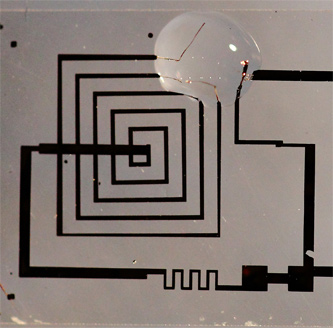A breakthrough technology that has been picking up steam over the past few months may have a whole host of useful and fantastic applications! Dissolvable electronics—which can be fairly quickly disposed of in small amounts of water—could be used in healing wounds and other medical procedures, transmitting critical military information with a lower risk of theft, and reducing e-waste pollution.

Circuit immersed in deionized water, shown dissolving for 1 minute, 2 minutes, 5 minutes, and 60 minutes. (Photo: John Rogers)
The foremost dissolvable electronics project is being led by researcher John Rogers at the University of Illinois at Urbana-Champaign. His “Born to Die” project, for developing dissolvable, bioresorbable electronics, is being funded by organizations that represent the widespread interests in generating this technology, including the National Institute of Health, the Defense Advanced Research Projects Agency (DARPA), and the U.S. Air Force.
Last year, Rogers described the development of a water-soluble, silicon-based circuit that completely dissolves in water. Recently, news of the findings of evaluating such implants in animal models has become available.

Source: Medgadget
For medical uses, the dissolvable circuits are created in modified, super-thin silk packaging that slowly degrades in the body, allowing doctors to control how long the device will last. The devices are remote-controlled and are responsive to radio frequencies. Rogers and his team build the capacitors, inductors, and resistors using water-soluble and biocompatible materials, including silicon nanomembranes for semiconductors, magnesium—already an important part of biological systems, and silicon dioxide or magnesium oxide as insulators.
Originally, the system used an antenna to receive the radio signals which powered the device. It was made by layering magnesium onto silk, and an ultra-thin version, with a 500nm thick magnesium antenna, would completely dissolve after two hours in deionized water at room temperature. A version six times thicker would take a few days to dissolve, and using radio as a power source would mean that devices meant to be implanted deeper would need even bigger antennas.
However, a more recent development led to making and powering some of these devices without an external electricity source. The latest dissolvable electronic devices use zinc oxide, a “piezoelectric” material that can produce electricity when bent or twisted, such as by movement of muscles in the body, pulsation of blood vessels, or beating of the heart.
Early testing used a device capable of delivering thermal therapy in rodents, releasing bacteria-killing heat to destroy even drug-resistant microbes. Researchers implanted the ephemeral electronics just beneath the skin of the mice and used an infrared camera to see if the devices were working. Then they raised the temperature at the implant site by just a few degrees to prevent bacterial growth in surrounding tissue. The implants worked as intended and then dissolved completely into the body.
Such research may lead to the development of future implants that treat acute pain, monitor surgical sites, and restore biological function before disappearing—becoming part of the people they have helped to heal—without the need for excisions.
DARPA’s interest in the research is at least two-fold. First, the biocompatible technology can be used for non-antibiotic, programmable bactericide, preventing surgical site infection and offering remote patient care without extraction surgery—perfect for overseas soldiers.
Second, both DARPA and the military are very interested in the technology for uses such as transmitting critical information and then destroying the originating device, and cellphones programmed to remotely destruct if they are lost or stolen. But the challenge of the technical complexity of a dissolvable cellphone, rather than its size, would put this possibility a lot further out. Still, it could start with “transient components,” such as memory cards and other parts that could be remotely destroyed. Ideas such as classified military systems with anti-tampering mechanisms, and lost cellphones with remotely-triggered transience so you won't have to worry about the data being picked up, may not be too far off.
Finally, though no less important, is the necessity for a greener form of e-waste disposal. Rapid progress in the development and dispersal of technology means an enormous amount of electronic waste is filling up landfills. The dissolvable electronic technology could go a long way towards eliminating e-waste and reducing pollution. There is some concern that the influx of metals from dissolvable devices could create toxic conditions in water supplies, but hopefully such concerns will be taken into serious consideration so that the wonderful possibilities of reducing e-waste pollution can become a reality.
Check out the video below to see DARPA’s medical chip dissolving before your very eyes!
 Suzanna Brooks joined Mouser Electronics in 2011 as a Technical Content Specialist and writes web content about the newest embedded and optoelectronic products available. Suzanna holds a Bachelor of Science degree from Embry-Riddle Aeronautical University and is a private pilot.
Suzanna Brooks joined Mouser Electronics in 2011 as a Technical Content Specialist and writes web content about the newest embedded and optoelectronic products available. Suzanna holds a Bachelor of Science degree from Embry-Riddle Aeronautical University and is a private pilot.
Advertisement
Learn more about Electronic Products MagazineMouser Electronics





